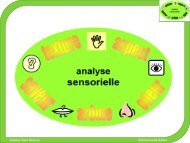_09 HDR Giboreau - Institut Paul Bocuse
_09 HDR Giboreau - Institut Paul Bocuse
_09 HDR Giboreau - Institut Paul Bocuse
Create successful ePaper yourself
Turn your PDF publications into a flip-book with our unique Google optimized e-Paper software.
Pangborn R.M. (1989) The evolution of sensory science and its interaction with IFT. Food Technology,<br />
43(9), 248–256, 307.<br />
Pastoureau M. (2003) Les couleurs de notre temps. Paris : Bonneton.<br />
Proust J. (1997) Perception et intermodalité – Approches actuelles de la question de Molyneux. Paris :<br />
Presses Universitaires de France.<br />
Raz C., Piper D., Nicod H., Haller R., Dusart N. & <strong>Giboreau</strong> A.(2008) From Sensory Marketing to Sensory<br />
Design. Food Quality and Preference, 19, 719–726.<br />
Reed S. (2007) Cognition, Théories et applications. Bruxelles : De Boeck Université.<br />
Richardson R.K., Morris E.R., Ross-Murphy S.B., Taylor L.J. & Dea I.C.M. (1989) Characterization of the<br />
perceived texture of thickened systems by dynamic viscosity measurements. Food Hydrocolloids, 3(3), 175-<br />
191.<br />
Rivière P., Montrozier R., Rogeaux M., Pagès J. & Saporta G. (2006) Adaptive preference target:<br />
Contribution of Kano’s model of satisfaction for an optimized preference analysis using a sequential<br />
consumer test. Food Quality and Preference, 17, 572-581.<br />
Rosch E. (1973) Natural categories. Cognitive Psychology, 4, 328-350.<br />
Rosch E. (1978) Principles of categorization. In E. Rosch & B.B. Lloyd (Eds.) Cognition and<br />
Categorization. Hilsdale, NJ: Erlbaum.<br />
Rosch E. & Mervis C.B. (1975) Family resemblances: studies in the internal structure of categories.<br />
Cognitive Psychology, 7, 573-605.<br />
Rosenthal V. & Visetti Y.M. (1999) Sens et temps de la gestalt. Intellectica, 1(28), 147- 227.<br />
Rouby C., Schaal B., Holley A., Dubois D. & Gervais R. (Éds.) (2002) Olfaction, taste, and cognition.<br />
Cambridge : Cambridge University Press.<br />
Sauvageot F. (1998) L'évaluation sensorielle : une technique qui mobilise l'activité cognitive des sujets tout<br />
autant que leur activité sensorielle. Industries Alimentaires Agricoles (Mars) 33-40.<br />
Sauvageot F. & Brémaud D. (2008) Comment comparer les performances de jurys effectuant des profils<br />
sensoriels sur les mêmes produits mais dans des pays différents : une proposition de l'AFNOR. 6 ème Journée<br />
du sensolier Diversités culturelles et sensorialités, Paris le 9 Octobre.<br />
Sauvageot F. & Dacremont C. (2001) L’évaluation sensorielle à la portée de tous – Les premiers pas en<br />
évaluation sensorielle. 4 ème Ed., Dijon : Ensbana – Université de Bourgogne.<br />
Sauvageot F., Herbreteau V., Shepherd M. & Dacremont C. (20<strong>09</strong>) A comparison between nine<br />
laboratories performing triangle tests. Soumis à Food Quality & Preference.<br />
Sauvageot F., Urdapilleta I. & Peyron D. (2006) Within and between variations of texts elicited from nine<br />
wine experts. Food Quality and Preference, 17(6) 429-444.<br />
Schifferstein H.N.J. (2006) The perceived importance of sensory modalities in product usage: a study of<br />
self-reports. Acta Psychologica, 121(1), 41-64.<br />
Schifferstein H.N.J. & Cleiren M.P.H.D. (2005) Capturine product experiences: a split-modality approach.<br />
Acta Psychologica, 118, 293-318.<br />
Schiffman R.S (2007) Sensation and perception, An integrated approach. (5 th Ed.) New York : J. Wiley &<br />
sons.<br />
Schiffman S. S., Reynolds, M. L. & Young, F. W. (1981) Introduction to multidimensional scaling: theory,<br />
methods, applications. New York : Academic Press.<br />
Schlich P. & Mac Ewan J. (1992) Cartographie des preferences. Un outil statistique pour l'industrie<br />
alimentaire. Science des aliments, 12, 339-355.<br />
Schlich P. (1993) Risk tables for discrimination tests Food Quality & Preference, 4, 141-151.<br />
- 117 -










